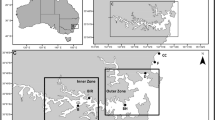Abstract
Pitfall trapping of terrestrial invertebrates in and around a seasonal woodland pond in northern Minnesota, USA revealed that large numbers of detritivorous and predaceous invertebrates from the forest floor were entering the pond as it dried. To assess the significance of terrestrial invertebrate foraging on litter processing and survival of aestivating aquatic invertebrates in dry pond basins, a small-scale exclusion study was conducted at two seasonal woodland ponds. Litter and invertebrates collected beneath pond waters were added to either 1-mm-mesh pouches (30×30×5 cm) that excluded large-bodied terrestrial invertebrates or 12-mm-mesh reference pouches that permitted entry. Pouches were left in dry basins for four weeks. Upon retrieval, I found that more aestivating aquatic invertebrates existed in exclusion than reference pouches (P<0.001), suggesting that predation from terrestrial invertebrates might influence aquatic forms. Impacts of excluding detritivorous terrestrial invertebrates on litter processing were equivocal. I argue, however, that the influence of terrestrial invertebrates on seasonal pond ecology has rarely been considered, and it might be significant in terms of overall ecosystem function.
Similar content being viewed by others
Literature Cited
Batzer, D. P., R. B. Rader, and S. A. Wissinger (eds.). 1999. Invertebrates in Freshwater Wetlands of North America: Ecology and Management. John Wiley and Sons, New York, NY, USA.
Batzer, D. P. and S. A. Wissinger. 1996. Ecology of insect communities in nontidal wetlands. Annual Review of Entomology 41: 75–100.
Higgins, M. J. and R. W. Merritt. 1999. Temporary woodland ponds in Michigan: invertebrate seasonal patterns and trophic relationships. p. 279–297. In D. P. Batzer, R. B. Rader, and S. A. Wissinger (eds.) Invertebrates in Freshwater Wetlands of North America: Ecology and Management. John Wiley and Sons, New York, NY, USA.
McMahon, R. F. 1991. Mollusca: Bivalvia. p. 315–399. In J. H. Thorp and A.P. Covich (eds.) Ecology and Classification of North American Freshwater Invertebrates. Academic Press, Inc., New York, NY, USA.
Polis, G. A. and S. D. Hurd. 1996. Allochthonous input across habitats, subsidized consumers, and apparent trophic cascades: examples from the ocean-land interface. p. 275–297. In G. A. Polis and K. O. Winemiller (eds.) Food Webs: Integration of Patterns and Dynamics. Chapman and Hall, New York, NY, USA.
Wallace, J. B., S. L. Eggert, J. L. Meyer, and J. R. Webster. 1997. Multiple trophic levels of a forest stream linked to terrestrial inputs. Science 227:102–104.
Wissinger, S. A. 1999. Ecology of wetland invertebrates: synthesis and applications for conservation and management. p. 1043–1086. In D. P. Batzer, R. B. Rader, and S. A. Wissinger (eds.) Invertebrates in Freshwater Wetlands of North America: Ecology and Management. John Wiley and Sons, New York, NY, USA.
Author information
Authors and Affiliations
Rights and permissions
About this article
Cite this article
Batzer, D.P. Movements of upland invertebrates into drying seasonal woodland ponds in northern Minnesota, USA. Wetlands 24, 904–907 (2004). https://doi.org/10.1672/0277-5212(2004)024[0904:MOUIID]2.0.CO;2
Received:
Revised:
Accepted:
Issue Date:
DOI: https://doi.org/10.1672/0277-5212(2004)024[0904:MOUIID]2.0.CO;2




